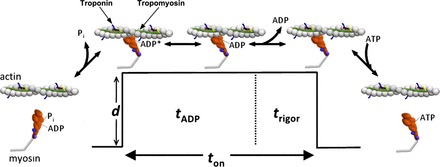Fig. 1.

Simplified consensus model of the cross-bridge cycle. The key steps of the ATPase cycle of myosin linked to the mechanical events. The first step, inorganic phosphate (Pi) release, is linked to actin strong binding and the movement of the lever arm that results in a unitary displacement (d). During this step, tropomyosin moves over the surface of actin to allow actomyosin binding, and this is thought to be the step regulated by Ca++, i.e., the weak-to-strong transition (28). There are likely two actomyosin state with ADP bound in the active site (AM-ADP) states (60), with acidosis thought to regulate the transition from the first (AM-ADP) to the second (AM-ADP) (17). We also believe that, when Pi is elevated, the powerstroke may not be reversed, but rather myosin dissociates from actin in a postpowerstroke state to account for Pi-induced increase in regulated thin-filament velocity (VRTF) (17, 18). Thus there are likely many more steps than represented here, but for clarity we have reduced the key steps.
